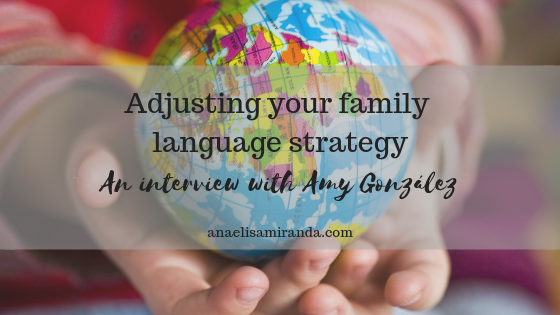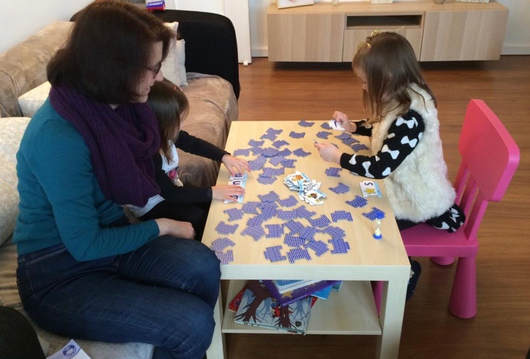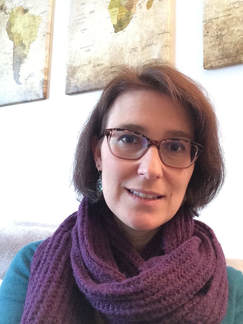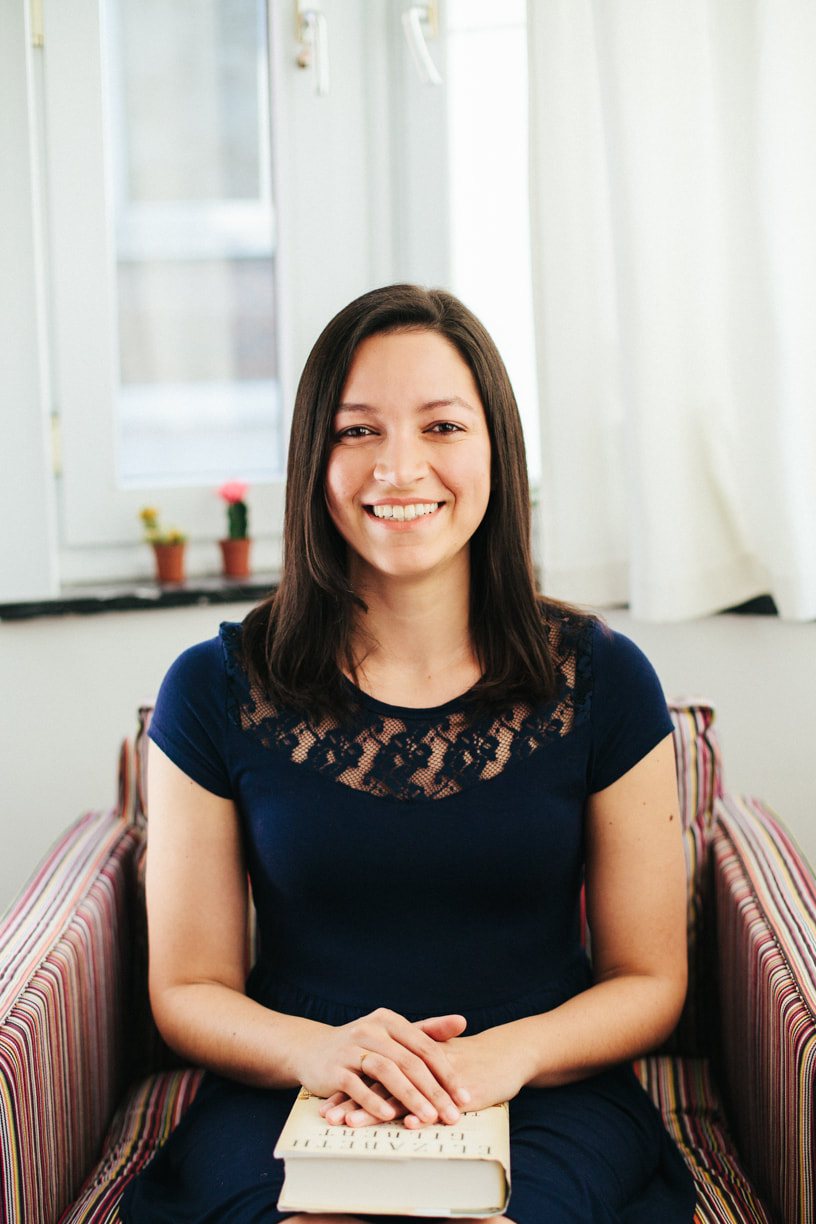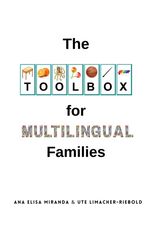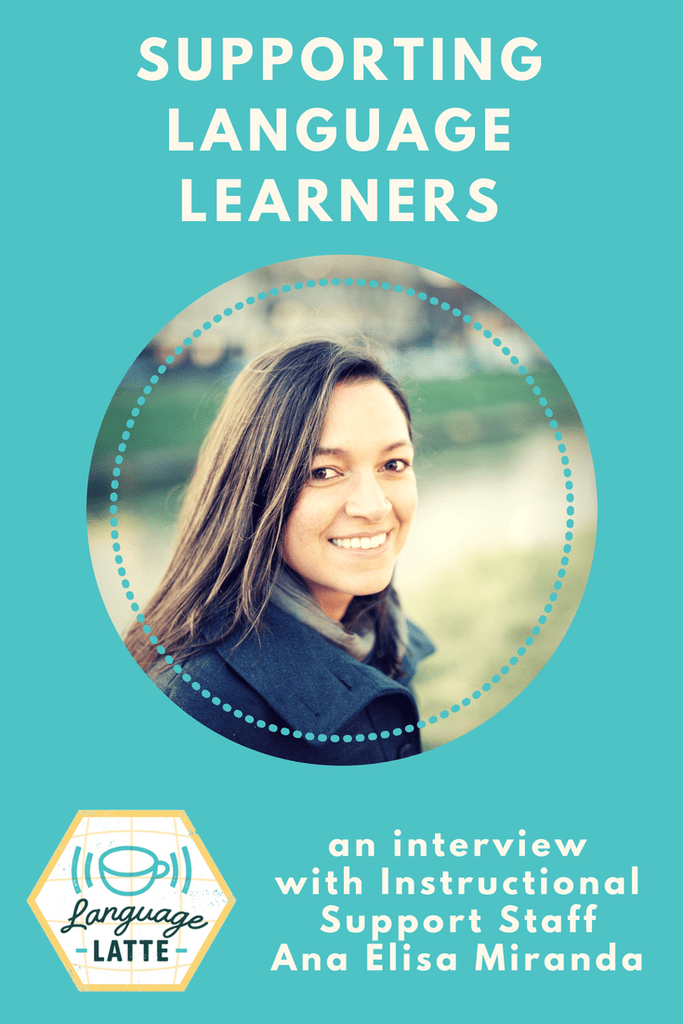When your first child is born and you decide on a bi/multilingual approach to raising them, you probably don't think of what could go wrong. You don't have a Plan B.
But the best of strategies and the most motivated of families might also fail to achieve their goals. As you'll learn from Amy's story, you do need a Plan B and you can't hesitate in trying something new until you find what works for your family.
I'm so glad to share this encouraging story, filled with great advice and ideas.
Check it out:
But the best of strategies and the most motivated of families might also fail to achieve their goals. As you'll learn from Amy's story, you do need a Plan B and you can't hesitate in trying something new until you find what works for your family.
I'm so glad to share this encouraging story, filled with great advice and ideas.
Check it out:
Tell us a little about yourself and your family.
I was born in France to French parents; when I was 10 my family moved to Spain, where I studied in an international British school. When time came to pursue my higher education, I chose to move to the U.K, where I spent 6 years before moving back to France.
It is in Paris -where we live today- that I met my husband, born and bred in Spain, who had moved here for work.
We are now the proud parents of 2 little girls aged 6 and 2, whom we decided to rear trilingual from their birth.
What’s your approach for raising them multilingual?
Full minority language immersion; though this has not always been the case. Our approach has evolved to full immersion to adapt to our circumstances.
Originally, having not read up on bilingual education, we went for the commonly-known strategy of One Person One Language (OPOL): Daddy speaking Spanish, me English, and using French as the family communication language. However, by the time she was 4, my eldest was a passive trilingual (she understood the minority languages but did not speak them). That was not our aim since we want our children to be fully trilingual and triliterate.
After reading up on bilingual education, I realised using the Majority Language as family communication language had been a big mistake. I carried out a test: I spent a whole day speaking English exclusively (which my husband speaks) to the whole family. My eldest picked up on it and straight away made attempts at using English!
As a result, we changed approach overnight, banning the use of the Majority Language from our home. We even went further, kicking the Majority Language out from our home, replacing anything French by English or Spanish. We try to make our home a minority language haven to immerse our daughters in our respective languages.
Many people travel to another country to learn their target language, in the belief immersion is the best method. We cannot travel every evening back to our minority language countries, but we can turn our home into a “Spanglish Embassy”. :)
Another big lesson learnt from this experience, is that a language strategy is not something set in stone. There is no one-size-fits-all approach. I have met a trilingual family with the same OPOL strategy we initially had, for whom it worked very well, and yet it did not for us. If your approach does not work, don’t be scared to test another one.
How do you incorporate the minority languages in your daily lives?
In fact, we do not “incorporate” the minority languages as such; we “live” them. They have become our way of life.
From the moment we walk through our main door, the use of French is banned, and 2 little Spanish and British flags stuck on the entrance door are there to remind everybody of it, should need be.
On week-days, my daughters breakfast to the sound of an online British radio, and to cartoons in English or Spanish on Netflix at the weekend.
When we walk out of our home, we still use the minority language between us but obviously we are back into the Majority Language community, so we use French with the people we interact with.
When we return home at the end of the day, we turn on the British radio; and when dad hits home we put the Spanish telly on. The only French tolerated is for my eldest daughter’s homework, though we try to always stick to English or Spanish to explain them. After French homework, we loop with homemade English homework: a few pages of reading and writing a sentence of her choice.
At weekends, I ensure to create a minority language audio background: minority language music from Spotify, Spanish online radio, Spanish telly, my daughters have a music player of their own in their bedroom with a selection of nursery rhymes CDs and audiobooks in the minority languages...
One of the keys to successfully raise multilingual kids is consistency. How does your family stay motivated and focused?
We were so close to failure that this works as an endless motivation for us. We finally understood what it takes and will not let go. Of course, there can be times when I feel low and frustrated, but my husband’s discrete but strong determination is my rock.
How are you introducing minority language literacy to your oldest daughter?
Literacy came to us a bit by accident. We had planned to let school teach our eldest daughter and build onto it. So when she learned the French ABC, we did the same in English and Spanish. But then, we applied for a Wednesday English school programme that sets entry tests to applicants. As part of the test, my daughter had to know phonics. Hence, I started teaching her phonics, and when she did not get a spot on that programme, I left the phonics at that. However, when French school introduced her to blending last year, my daughter used this and her knowledge of English phonics to start reading on her own in English and Spanish! In France, formal teaching of reading only starts when children are aged 6, but I could not see her waiting 9 months to satisfy her thirst for reading. For that reason, I took it on me to initiate her to reading in English.
This year, she has a handful of bilingual classmates that belong to the international division of her school, where they have 6 hours of teaching in English. My daughter has expressed the wish to join the division, that entails sitting an entry test on reading and writing. Hence, I have recently started teaching her to write. This is why I have introduced the “English” homework mentioned above.
Can you tell us about one of your proudest moments?
My proudest moment was when one day, a friend who is a bilingual education skeptic, literally had his jaw drop in utter disbelief when he heard my eldest addressing me in English. It seemed like a scene straight out of a cartoon! Nothing was said, but the jaw dropping and gobsmacked look said it all. That was my proud moment: proud of my daughter, proud not to have given up, proud that my daughter demonstrated that bilingual education works.
What has been the biggest challenge so far? How do you try to overcome it?
My eldest daughter’s resistance to the minority languages! French is always on a pedestal and she never misses an opportunity to say she prefers French or slip a French word if she can help it.
To overcome it, we set that ban on French at home and explained the change to my daughter by giving her a “mission,” contained in a pretty golden envelope:
3 tiny flags for each one of our languages. We asked her to stick the two minority language flags on the outside of our front door, to remind her which languages she should use when she walks into the house. On the inside of the front door, we had her post the French flag to remind her that, on the way out, she could now switch to using the Majority Language. This very visual concept really helped her to understand the change occurring in our home, and acted as a reminder whenever she deliberately slipped up and we sent her to look them up.
We regularly remind her of why we insist so much on languages, and particularly English as she does not understand why her French mother insists on speaking English. We explain to her the importance of the English language in society, how it will help her later on at school and in life. We never miss an opportunity to point at minority language speakers, especially children like her. It seems like it is slowly sinking in. Having a handful bilingual classmates in her year has also greatly helped.
What are your favourite minority language resources at the moment?
My daughters’ music player and Julia Donaldson audiobooks. My little one has just discovered how enjoyable they are and regularly asks her sister or me to play “What the ladybird heard and other stories” on their player.
This kind of resources are great because it develops the child’s taste for books, independent reading and it creates minority language exposure in their own room at their demand.
What’s your advice for parents considering teaching their kids to read and write at home?
Set up a routine! I am convinced that what has really helped my eldest daughter in developing her reading skills is having her reading every single day. It does not have to be a whole set of phonics flashcards or book, but a few cards or pages every day.
For phonics, make it playful, use fun flashcards, use props such as magnetic letters, foam letters, plasticine...
For reading, make it enjoyable, snuggle together on the sofa with a nice warm blanket, turn all the media off, ask your spouse to entertain the other siblings. Make it a nice one-on-one time.
Tell us about your blog, Our ml home.
When I was at my lowest in the trilingual education adventure, I came across an amazing community at the Bilingual Zoo. They have supported me and inspired me. The book written by the forum’s administrator, Adam Beck, “Maximize Your Child’s Bilingual Ability” has changed my vision of how to go about trilingual education and taught me to think out of the box. Over time, I myself started helping other members suggesting ideas, giving tips. A fellow bilingual mum suggested I should write about my experience, which made me realise that through a blog, I might be able to help other struggling bilingual parents.
What bilingual parents seemed to appreciate about my posts at the Bilingual Zoo were my tips and ideas, so I decided to design my blog as a little “toolbox” of practical tips and ideas. At the end of my posts, readers are invited to share their own tips and ideas on the topic. Each child being different, some ideas might work whilst others won’t. This is why I would love the blog to act as a bank of ideas bilingual parents could pick and choose from according to their personal circumstances and child’s personality.
We were so close to failure that this works as an endless motivation for us. We finally understood what it takes and will not let go. Of course, there can be times when I feel low and frustrated, but my husband’s discrete but strong determination is my rock.
How are you introducing minority language literacy to your oldest daughter?
Literacy came to us a bit by accident. We had planned to let school teach our eldest daughter and build onto it. So when she learned the French ABC, we did the same in English and Spanish. But then, we applied for a Wednesday English school programme that sets entry tests to applicants. As part of the test, my daughter had to know phonics. Hence, I started teaching her phonics, and when she did not get a spot on that programme, I left the phonics at that. However, when French school introduced her to blending last year, my daughter used this and her knowledge of English phonics to start reading on her own in English and Spanish! In France, formal teaching of reading only starts when children are aged 6, but I could not see her waiting 9 months to satisfy her thirst for reading. For that reason, I took it on me to initiate her to reading in English.
This year, she has a handful of bilingual classmates that belong to the international division of her school, where they have 6 hours of teaching in English. My daughter has expressed the wish to join the division, that entails sitting an entry test on reading and writing. Hence, I have recently started teaching her to write. This is why I have introduced the “English” homework mentioned above.
Can you tell us about one of your proudest moments?
My proudest moment was when one day, a friend who is a bilingual education skeptic, literally had his jaw drop in utter disbelief when he heard my eldest addressing me in English. It seemed like a scene straight out of a cartoon! Nothing was said, but the jaw dropping and gobsmacked look said it all. That was my proud moment: proud of my daughter, proud not to have given up, proud that my daughter demonstrated that bilingual education works.
What has been the biggest challenge so far? How do you try to overcome it?
My eldest daughter’s resistance to the minority languages! French is always on a pedestal and she never misses an opportunity to say she prefers French or slip a French word if she can help it.
To overcome it, we set that ban on French at home and explained the change to my daughter by giving her a “mission,” contained in a pretty golden envelope:
3 tiny flags for each one of our languages. We asked her to stick the two minority language flags on the outside of our front door, to remind her which languages she should use when she walks into the house. On the inside of the front door, we had her post the French flag to remind her that, on the way out, she could now switch to using the Majority Language. This very visual concept really helped her to understand the change occurring in our home, and acted as a reminder whenever she deliberately slipped up and we sent her to look them up.
We regularly remind her of why we insist so much on languages, and particularly English as she does not understand why her French mother insists on speaking English. We explain to her the importance of the English language in society, how it will help her later on at school and in life. We never miss an opportunity to point at minority language speakers, especially children like her. It seems like it is slowly sinking in. Having a handful bilingual classmates in her year has also greatly helped.
What are your favourite minority language resources at the moment?
My daughters’ music player and Julia Donaldson audiobooks. My little one has just discovered how enjoyable they are and regularly asks her sister or me to play “What the ladybird heard and other stories” on their player.
This kind of resources are great because it develops the child’s taste for books, independent reading and it creates minority language exposure in their own room at their demand.
What’s your advice for parents considering teaching their kids to read and write at home?
Set up a routine! I am convinced that what has really helped my eldest daughter in developing her reading skills is having her reading every single day. It does not have to be a whole set of phonics flashcards or book, but a few cards or pages every day.
For phonics, make it playful, use fun flashcards, use props such as magnetic letters, foam letters, plasticine...
For reading, make it enjoyable, snuggle together on the sofa with a nice warm blanket, turn all the media off, ask your spouse to entertain the other siblings. Make it a nice one-on-one time.
Tell us about your blog, Our ml home.
When I was at my lowest in the trilingual education adventure, I came across an amazing community at the Bilingual Zoo. They have supported me and inspired me. The book written by the forum’s administrator, Adam Beck, “Maximize Your Child’s Bilingual Ability” has changed my vision of how to go about trilingual education and taught me to think out of the box. Over time, I myself started helping other members suggesting ideas, giving tips. A fellow bilingual mum suggested I should write about my experience, which made me realise that through a blog, I might be able to help other struggling bilingual parents.
What bilingual parents seemed to appreciate about my posts at the Bilingual Zoo were my tips and ideas, so I decided to design my blog as a little “toolbox” of practical tips and ideas. At the end of my posts, readers are invited to share their own tips and ideas on the topic. Each child being different, some ideas might work whilst others won’t. This is why I would love the blog to act as a bank of ideas bilingual parents could pick and choose from according to their personal circumstances and child’s personality.
| Amy is a French mum of two living in Paris. She works in insurance broking and has a blog about raising trilingual children - Our ml home. You can also find Our ml home on Facebook and Twitter. Make sure you visit Our ml home - explore all her practical tips, share your experience, ask questions or just say hello! |
★★★
Get posts, resources, meet other multilingual parents and ask all your burning questions about multilingualism and literacy:
Get posts, resources, meet other multilingual parents and ask all your burning questions about multilingualism and literacy:

